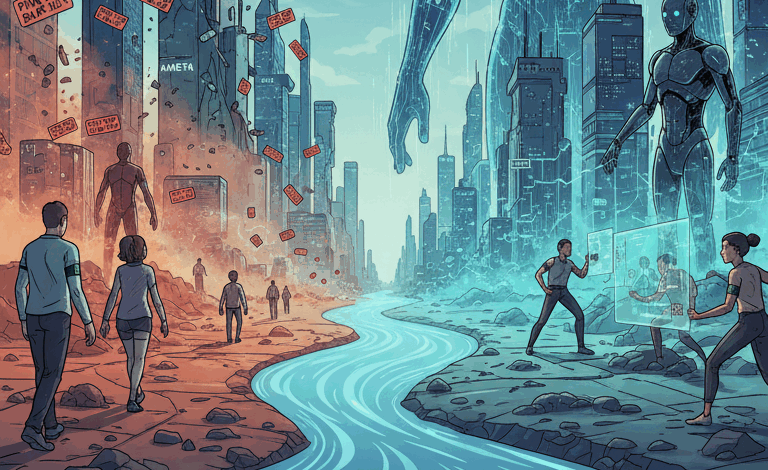New Wave of Layoffs Hits Tech Giants: Rivian, Meta, and Amazon Cut Jobs

I. Introduction: The Tech Layoff Echo Chamber
Remember the heady days when a tech job was practically a guaranteed path to prosperity? The ping-pong tables, the catered lunches, the stock options that seemed to multiply overnight? Well, as the leaves turn in late 2025, the tech industry is ringing in the season with more pink slips than celebratory toasts. A new wave of layoffs is crashing against the shores of tech giants like Rivian, Meta, and Amazon, sending shivers down the spine of the workforce. This isn’t merely a blip on the radar; it’s a significant trend reshaping the entire landscape. Tens of thousands of jobs have vanished this year alone, victims of a potent cocktail: economic slowdowns, the lingering aftereffects of the pandemic’s distorted boom, and the relentlessly accelerating rise of Artificial Intelligence.
II. Déjà Vu All Over Again? A Historical Look at Tech’s Job Rollercoaster
This feeling… this unease… it’s not entirely unfamiliar, is it? This isn’t our first rodeo on the tech industry’s turbulent rollercoaster. A quick trip down memory lane reminds us of the dot-com bust of the early 2000s, a period of exuberance followed by a painful reckoning. And then came the 2008 financial crisis, another wave of layoffs that swept across the sector. Tech layoffs, it seems, are a recurring, if unwelcome, guest at the industry’s table.
Looking more recently, we see that companies like Amazon and Meta went on massive hiring sprees during the COVID-19 pandemic, fueled by surging demand and the imperative to scale. They often doubled their workforce, creating empires of employees. But as the world normalized, and the extraordinary pandemic demand subsided, these behemoths found themselves “overstaffed,” burdened by the very empires they had built. The party was over, and the cleanup crew was arriving.
Adding to the pressure is the current economic climate. Inflation persists, interest rates are rising, and venture capital funding, once freely flowing, is beginning to dry up. These economic headwinds are forcing companies to tighten their belts, scrutinize every expense, and, inevitably, make difficult decisions about their workforce.
III. The AI Awakening & The Bottom Line: Why Companies Are Cutting Deep
But something feels different this time, doesn’t it? While economic cycles and pandemic-induced distortions play their part, there’s another, more profound force at work: the undeniable, unstoppable force of Artificial Intelligence and automation. This isn’t merely about incremental efficiency gains; it’s about fundamentally reshaping what roles are needed, and who – or what – will perform them.
Consider Meta. The company is actively streamlining its AI teams, consolidating what it perceives as “bloated” departments, and creating “talent-dense” units focused on pushing the boundaries of AI. Simultaneously, they are aggressively hiring for new AI frontiers like the enigmatic “TBD Lab.” What does this tell us? Meta is betting big on AI, even if it means re-evaluating its existing workforce and prioritizing new skills over old loyalties.
Amazon’s CEO, Andy Jassy, has been even more explicit, stating that AI will “reduce our total corporate workforce.” This isn’t just corporate jargon. Automation is no longer a buzzword; it’s a job-replacer, particularly in areas like HR and warehouse operations, where AI-powered systems can perform tasks previously done by human employees.
Underlying all of this is the relentless pressure from shareholders. In today’s market, profitability is king, and growth at all costs is no longer a viable strategy. Investors are demanding returns, and companies are responding with swift cost-cutting measures, including mass layoffs.
The tech market itself is also maturing. The days of hyper-growth, fueled by endless customer acquisition, are waning. Companies are shifting their focus from simply gaining new users to diversifying their product offerings and optimizing their existing operations. This transition requires a different skill set and a different staffing model.
Rivian, the electric vehicle maker, faces its own unique set of challenges. Slower-than-expected electric vehicle demand, the expiration of federal tax credits, and strategic decisions to conserve cash for their upcoming, more affordable R2 model have all contributed to the company’s need to cut costs.
IV. The Unseen Costs: Controversies & The Human Side of Tech
But behind the spreadsheets and the investor presentations lies a darker, more troubling reality: the human cost of these decisions. While the tech industry often touts its progressive values, the reality on the ground can be far more complex and, at times, deeply unsettling.
Rivian’s story is particularly fraught. Reports from its Normal, Illinois plant paint a disturbing picture: OSHA violations, severe injuries (fractured skulls, amputations), inadequate training, and allegations of prioritizing production quotas over worker safety. Critics question the company’s use of H-1B visas and state incentives while simultaneously laying off US workers and reducing transparency around local headcount. Furthermore, Rivian faces a barrage of legal and ethical challenges, from an IPO fraud settlement to harassment and discrimination lawsuits against senior leadership.
At Meta, a morale crisis simmers beneath the surface. Employees dispute the company’s claims of “performance-based” layoffs, alleging that those on leave were targeted and that a “scarlet letter” was effectively branded on affected workers. The atmosphere, some say, feels more like a “rank and yank” culture than a meritocracy. Adding insult to injury, the company’s decision to significantly increase executive bonuses immediately after mass layoffs was widely condemned as “tone-deaf” and indicative of a leadership team prioritizing its own enrichment over the well-being of its employees. The huge salaries being offered to external AI hires have further fueled internal resentment and exacerbated the “morale crisis” within existing teams.
Amazon, too, faces scrutiny for its treatment of its workforce. The notoriously demanding conditions in its fulfillment centers – grueling shifts, unrealistic productivity targets (300 items/hour!), constant surveillance, high injury rates, and even struggles to take bathroom breaks – have long been a source of controversy. The company’s aggressive tactics against unionization efforts have also drawn criticism. Some argue that “efficiency” and “AI” are merely corporate buzzwords used to justify job cuts, even in a highly profitable company with vast cash reserves.
V. The Road Ahead: Navigating Tech’s New Era
So, what does the future hold for the tech workforce? The era of easy money and endless growth is over. Layoffs aren’t necessarily over, either, but they are evolving. Expect more targeted “organizational rebalancing” rather than panicked, across-the-board cuts.
The skill landscape is also shifting dramatically. The days of the generalist are numbered; the future belongs to the specialist. High demand will continue for AI/ML engineers, cybersecurity experts, cloud architects, and data scientists.
But technical prowess alone will not be enough. “Soft skills” – analytical thinking, resilience, adaptability, and leadership – are becoming as crucial as technical expertise. Companies will increasingly use skills assessments over traditional resumes, focusing on identifying top-tier talent with niche expertise.
Continuous learning and reskilling in AI and related fields are no longer optional; they are essential for survival. Those who fail to adapt will be left behind. Flexible work models and project-based employment are here to stay, further transforming the traditional employment landscape.
Looking at specific companies, Rivian’s future hinges on the success of its more affordable R2 SUV in 2026, which will be critical for the company’s long-term viability and profitability. Meta is doubling down on next-generation AI models (TBD Lab) to stay competitive, even if it means internal friction and job restructuring. Amazon, meanwhile, is pursuing an aggressive roadmap to automate up to 75% of its warehouse operations, potentially impacting hundreds of thousands of jobs by 2027. The future of Amazon’s workforce may look more metallic than human.
VI. Conclusion: Adapt or Be Automated?
The tech industry is in a state of profound and unsettling flux. Layoffs, economic pressures, and the undeniable surge of AI are reshaping everything we thought we knew about this sector. While unsettling, these changes highlight a pivot towards a more efficient, AI-driven, and specialized tech landscape.
The future is not something to be feared, but rather something to be understood and navigated. For workers, adaptability, continuous learning, and the acquisition of niche skills will be paramount. For companies, balancing innovation with ethical treatment of their employees and a commitment to sustainable growth remains the ultimate challenge. The question is no longer whether AI will transform the tech industry, but how we, as individuals and as a society, will adapt to this transformation. The answer to that question will determine who thrives, and who is left behind, in the brave new world of tech.





